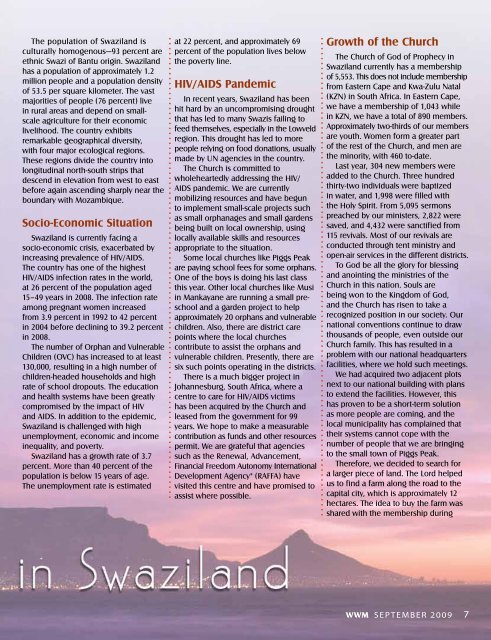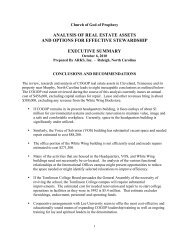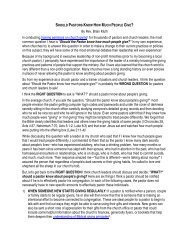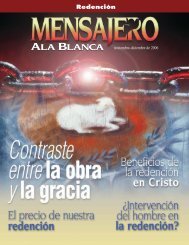announcement - Church of God of Prophecy
announcement - Church of God of Prophecy
announcement - Church of God of Prophecy
Create successful ePaper yourself
Turn your PDF publications into a flip-book with our unique Google optimized e-Paper software.
The population <strong>of</strong> Swaziland is<br />
culturally homogenous—93 percent are<br />
ethnic Swazi <strong>of</strong> Bantu origin. Swaziland<br />
has a population <strong>of</strong> approximately 1.2<br />
million people and a population density<br />
<strong>of</strong> 53.5 per square kilometer. The vast<br />
majorities <strong>of</strong> people (76 percent) live<br />
in rural areas and depend on smallscale<br />
agriculture for their economic<br />
livelihood. The country exhibits<br />
remarkable geographical diversity,<br />
with four major ecological regions.<br />
These regions divide the country into<br />
longitudinal north-south strips that<br />
descend in elevation from west to east<br />
before again ascending sharply near the<br />
boundary with Mozambique.<br />
Socio-Economic Situation<br />
Swaziland is currently facing a<br />
socio-economic crisis, exacerbated by<br />
increasing prevalence <strong>of</strong> HIV/AIDS.<br />
The country has one <strong>of</strong> the highest<br />
HIV/AIDS infection rates in the world,<br />
at 26 percent <strong>of</strong> the population aged<br />
15–49 years in 2008. The infection rate<br />
among pregnant women increased<br />
from 3.9 percent in 1992 to 42 percent<br />
in 2004 before declining to 39.2 percent<br />
in 2008.<br />
The number <strong>of</strong> Orphan and Vulnerable<br />
Children (OVC) has increased to at least<br />
130,000, resulting in a high number <strong>of</strong><br />
children-headed households and high<br />
rate <strong>of</strong> school dropouts. The education<br />
and health systems have been greatly<br />
compromised by the impact <strong>of</strong> HIV<br />
and AIDS. In addition to the epidemic,<br />
Swaziland is challenged with high<br />
unemployment, economic and income<br />
inequality, and poverty.<br />
Swaziland has a growth rate <strong>of</strong> 3.7<br />
percent. More than 40 percent <strong>of</strong> the<br />
population is below 15 years <strong>of</strong> age.<br />
The unemployment rate is estimated<br />
at 22 percent, and approximately 69<br />
percent <strong>of</strong> the population lives below<br />
the poverty line.<br />
HIV/AIDS Pandemic<br />
In recent years, Swaziland has been<br />
hit hard by an uncompromising drought<br />
that has led to many Swazis failing to<br />
feed themselves, especially in the Lowveld<br />
region. This drought has led to more<br />
people relying on food donations, usually<br />
made by UN agencies in the country.<br />
The <strong>Church</strong> is committed to<br />
wholeheartedly addressing the HIV/<br />
AIDS pandemic. We are currently<br />
mobilizing resources and have begun<br />
to implement small-scale projects such<br />
as small orphanages and small gardens<br />
being built on local ownership, using<br />
locally available skills and resources<br />
appropriate to the situation.<br />
Some local churches like Piggs Peak<br />
are paying school fees for some orphans.<br />
One <strong>of</strong> the boys is doing his last class<br />
this year. Other local churches like Musi<br />
in Mankayane are running a small preschool<br />
and a garden project to help<br />
approximately 20 orphans and vulnerable<br />
children. Also, there are district care<br />
points where the local churches<br />
contribute to assist the orphans and<br />
vulnerable children. Presently, there are<br />
six such points operating in the districts.<br />
There is a much bigger project in<br />
Johannesburg, South Africa, where a<br />
centre to care for HIV/AIDS victims<br />
has been acquired by the <strong>Church</strong> and<br />
leased from the government for 99<br />
years. We hope to make a measurable<br />
contribution as funds and other resources<br />
permit. We are grateful that agencies<br />
such as the Renewal, Advancement,<br />
Financial Freedom Autonomy International<br />
Development Agency* (RAFFA) have<br />
visited this centre and have promised to<br />
assist where possible.<br />
Growth <strong>of</strong> the <strong>Church</strong><br />
The <strong>Church</strong> <strong>of</strong> <strong>God</strong> <strong>of</strong> <strong>Prophecy</strong> in<br />
Swaziland currently has a membership<br />
<strong>of</strong> 5,553. This does not include membership<br />
from Eastern Cape and Kwa-Zulu Natal<br />
(KZN) in South Africa. In Eastern Cape,<br />
we have a membership <strong>of</strong> 1,043 while<br />
in KZN, we have a total <strong>of</strong> 890 members.<br />
Approximately two-thirds <strong>of</strong> our members<br />
are youth. Women form a greater part<br />
<strong>of</strong> the rest <strong>of</strong> the <strong>Church</strong>, and men are<br />
the minority, with 460 to-date.<br />
Last year, 304 new members were<br />
added to the <strong>Church</strong>. Three hundred<br />
thirty-two individuals were baptized<br />
in water, and 1,998 were filled with<br />
the Holy Spirit. From 5,095 sermons<br />
preached by our ministers, 2,822 were<br />
saved, and 4,432 were sanctified from<br />
115 revivals. Most <strong>of</strong> our revivals are<br />
conducted through tent ministry and<br />
open-air services in the different districts.<br />
To <strong>God</strong> be all the glory for blessing<br />
and anointing the ministries <strong>of</strong> the<br />
<strong>Church</strong> in this nation. Souls are<br />
being won to the Kingdom <strong>of</strong> <strong>God</strong>,<br />
and the <strong>Church</strong> has risen to take a<br />
recognized position in our society. Our<br />
national conventions continue to draw<br />
thousands <strong>of</strong> people, even outside our<br />
<strong>Church</strong> family. This has resulted in a<br />
problem with our national headquarters<br />
facilities, where we hold such meetings.<br />
We had acquired two adjacent plots<br />
next to our national building with plans<br />
to extend the facilities. However, this<br />
has proven to be a short-term solution<br />
as more people are coming, and the<br />
local municipality has complained that<br />
their systems cannot cope with the<br />
number <strong>of</strong> people that we are bringing<br />
to the small town <strong>of</strong> Piggs Peak.<br />
Therefore, we decided to search for<br />
a larger piece <strong>of</strong> land. The Lord helped<br />
us to find a farm along the road to the<br />
capital city, which is approximately 12<br />
hectares. The idea to buy the farm was<br />
shared with the membership during<br />
WWM S E P T E M B E R 2 0 0 9 7
















